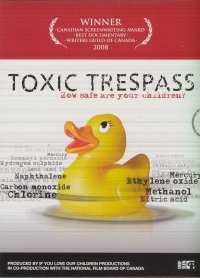| ________________
CM . . . . Volume XVII Number 2. . . .September 10, 2010. 
 |
Toxic Trespass: How Safe Are Your Children.
Barri Cohen (Writer & Director). Dorothy Goldin Rosenberg, Mehernaz Lentin & Anita Lee (Producers). Dorothy Goldin Rosenberg & Silva Basmajian (Executive Producers).
Montreal, PQ: National Film Board of Canada, 2008.
2-Disc DVD set, Director’s Cut 83 min., TV Version 53 min., DVD, $99.95.
Includes Taking Action on Children’s Health and Environment: An Education and Community Resource Guide to Accompany Toxic Tresspass, 67 pp., pbk.
Order Number: 183C 9108 356.
Subject Headings:
Children and the environment-Canada.
Pollution-Health aspects-Canada.
Grades 10 and up / Ages 15 and up.
Review by Joanne Peters.
***/4
|
| |
|

The jacket for the DVD depicts that cutest of childhood bath toys: the smiling yellow rubber ducky. But, that little duck is floating in a pool of chemicals, many of which are poisonous, and the plastic from which it is made is not the healthiest of substances, either. The film begins with a little girl stating “I am Ada, and I am polluted,” and then cuts to a home video of a playpen full of plastic toys. From earliest childhood, Ada has been surrounded by plastic and chemicals, and, as a result, her mother begins to wonder just how this exposure has effected her daughter’s personal body chemistry.
Blood tests reveal huge levels of heavy metals and chemicals found in the toys and flame/stain retardants applied to many fabrics worn by kids and found in household furnishings. Regrettably, there are no known safe levels for these chemicals, and decades of exposure have led to increasing levels of asthma and similar respiratory diseases, as well as childhood cancers. In fact, by 2055, the World Health Organization estimates that 50% of the world will suffer from some form of asthma.
But, it is not only children who are facing serious health problems; in heavily industrialized cities, such as Windsor and Sarnia, workers experience high levels of hospitalization due to a variety of similar ailments. Throughout the film, vignettes entitled “Toxic Facts” provide statistics on levels of illness, on the chemical composition of commonly used household products (pesticides, cleaning agents, and many air-borne sprays), and their impact upon the body’s endocrine and nervous systems. Children are particularly vulnerable; damage is cumulative, and the full effects of continual exposure to toxic compounds do not fully present until years (sometimes decades) later.
A substantial body of research in Europe and South America validates the fears of those who worry about the outcome of chemical exposure. Amongst pregnant women, high rates of miscarriage and highly imbalanced ratios of male/female infant birth are further evidence of the outcome of bodily pollution.
Industrial lobby groups are powerful, particularly in locations where the production of chemicals or high levels of industrial activity are the major employers. Protest can have serious economic impact, and, in competitive times, few can afford to lose their jobs. However, in Toxic Trespass, we see both individuals and citizens’ groups challenging big industry and often obtaining concessions and changes to the way that business is done.
For most of us who grew up in the 1960’s and 1970’s, plastics and chemicals were the constituent components of civilized 20th century life. But a weed-free, sanitized, and plasticized world has consequences, and the consequences for personal health are huge. “Retro” footage from old films which celebrated chemical progress are juxtaposed with interviews with a range of medical and scientific experts: pediatric oncologists who treat children presenting with unexpectedly virulent cancers, industrial health specialists who see healthy young workers become disabled by early onsets of work-related diseases, and citizens who are mad as hell and have decided that they are not going to take it anymore.
Toxic Trespass would make interesting supplementary class material for senior high students in biology and environmental studies. Users should preview the film before using it in class in order to find those portions which might be most relevant to their teaching needs. There’s a huge amount of material packed into the 53 minutes television version, and the resource guide which accompanies the DVD, Taking Action on Children’s Health and Environment, enhances awareness of “toxic trespass” as well as offering a wealth of resources and strategies for productive personal and community action. Toxic Trespass would be useful, not only for high school audio-visual collections, but also for grass-roots groups with a “green” perspective.
Recommended.
Just retired, Joanne Peters was the teacher-librarian at Kelvin High School in Winnipeg, MB.

To comment on this title or this review, send mail to
cm@umanitoba.ca.
Copyright © the Manitoba Library Association. Reproduction for personal use is permitted only if this copyright notice is maintained. Any other reproduction is prohibited without permission.
NEXT REVIEW |
TABLE OF CONTENTS FOR THIS ISSUE- September 10, 2010.
AUTHORS |
TITLES |
MEDIA REVIEWS |
PROFILES |
BACK ISSUES |
SEARCH |
CMARCHIVE |
HOME |
